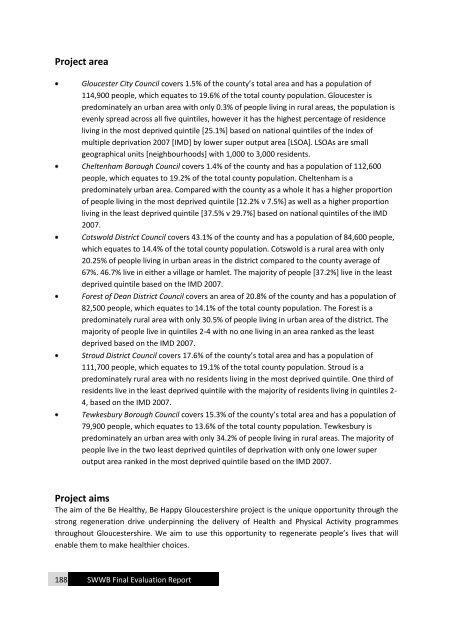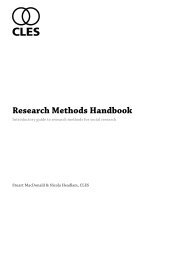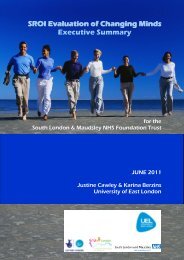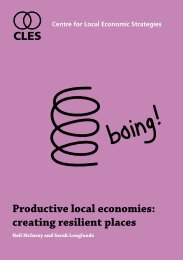Aim and objectives of the report - CLES
Aim and objectives of the report - CLES
Aim and objectives of the report - CLES
- No tags were found...
Create successful ePaper yourself
Turn your PDF publications into a flip-book with our unique Google optimized e-Paper software.
Project areaGloucester City Council covers 1.5% <strong>of</strong> <strong>the</strong> county’s total area <strong>and</strong> has a population <strong>of</strong>114,900 people, which equates to 19.6% <strong>of</strong> <strong>the</strong> total county population. Gloucester ispredominately an urban area with only 0.3% <strong>of</strong> people living in rural areas, <strong>the</strong> population isevenly spread across all five quintiles, however it has <strong>the</strong> highest percentage <strong>of</strong> residenceliving in <strong>the</strong> most deprived quintile [25.1%] based on national quintiles <strong>of</strong> <strong>the</strong> index <strong>of</strong>multiple deprivation 2007 [IMD] by lower super output area [LSOA]. LSOAs are smallgeographical units [neighbourhoods] with 1,000 to 3,000 residents.Cheltenham Borough Council covers 1.4% <strong>of</strong> <strong>the</strong> county <strong>and</strong> has a population <strong>of</strong> 112,600people, which equates to 19.2% <strong>of</strong> <strong>the</strong> total county population. Cheltenham is apredominately urban area. Compared with <strong>the</strong> county as a whole it has a higher proportion<strong>of</strong> people living in <strong>the</strong> most deprived quintile [12.2% v 7.5%] as well as a higher proportionliving in <strong>the</strong> least deprived quintile [37.5% v 29.7%] based on national quintiles <strong>of</strong> <strong>the</strong> IMD2007.Cotswold District Council covers 43.1% <strong>of</strong> <strong>the</strong> county <strong>and</strong> has a population <strong>of</strong> 84,600 people,which equates to 14.4% <strong>of</strong> <strong>the</strong> total county population. Cotswold is a rural area with only20.25% <strong>of</strong> people living in urban areas in <strong>the</strong> district compared to <strong>the</strong> county average <strong>of</strong>67%. 46.7% live in ei<strong>the</strong>r a village or hamlet. The majority <strong>of</strong> people [37.2%] live in <strong>the</strong> leastdeprived quintile based on <strong>the</strong> IMD 2007.Forest <strong>of</strong> Dean District Council covers an area <strong>of</strong> 20.8% <strong>of</strong> <strong>the</strong> county <strong>and</strong> has a population <strong>of</strong>82,500 people, which equates to 14.1% <strong>of</strong> <strong>the</strong> total county population. The Forest is apredominately rural area with only 30.5% <strong>of</strong> people living in urban area <strong>of</strong> <strong>the</strong> district. Themajority <strong>of</strong> people live in quintiles 2-4 with no one living in an area ranked as <strong>the</strong> leastdeprived based on <strong>the</strong> IMD 2007.Stroud District Council covers 17.6% <strong>of</strong> <strong>the</strong> county’s total area <strong>and</strong> has a population <strong>of</strong>111,700 people, which equates to 19.1% <strong>of</strong> <strong>the</strong> total county population. Stroud is apredominately rural area with no residents living in <strong>the</strong> most deprived quintile. One third <strong>of</strong>residents live in <strong>the</strong> least deprived quintile with <strong>the</strong> majority <strong>of</strong> residents living in quintiles 2-4, based on <strong>the</strong> IMD 2007.Tewkesbury Borough Council covers 15.3% <strong>of</strong> <strong>the</strong> county’s total area <strong>and</strong> has a population <strong>of</strong>79,900 people, which equates to 13.6% <strong>of</strong> <strong>the</strong> total county population. Tewkesbury ispredominately an urban area with only 34.2% <strong>of</strong> people living in rural areas. The majority <strong>of</strong>people live in <strong>the</strong> two least deprived quintiles <strong>of</strong> deprivation with only one lower superoutput area ranked in <strong>the</strong> most deprived quintile based on <strong>the</strong> IMD 2007.Project aimsThe aim <strong>of</strong> <strong>the</strong> Be Healthy, Be Happy Gloucestershire project is <strong>the</strong> unique opportunity through <strong>the</strong>strong regeneration drive underpinning <strong>the</strong> delivery <strong>of</strong> Health <strong>and</strong> Physical Activity programmesthroughout Gloucestershire. We aim to use this opportunity to regenerate people’s lives that willenable <strong>the</strong>m to make healthier choices.188 SWWB Final Evaluation Report









